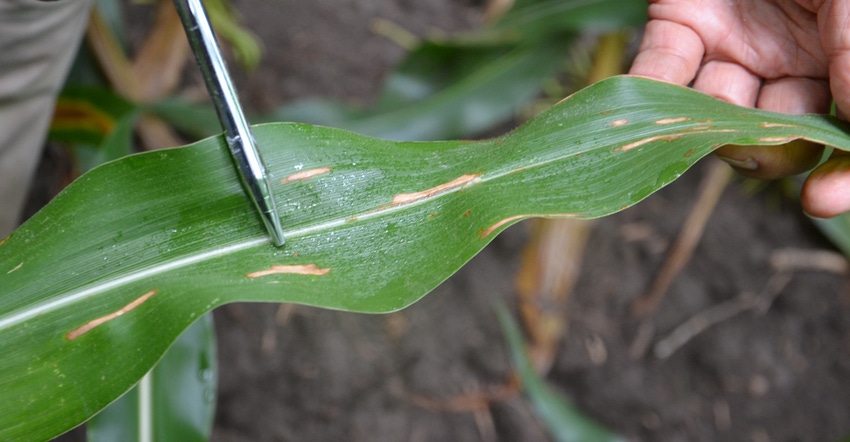
If your corn is in the dough stage or even late milk stage, you may think you can stop scouting and worrying about disease. Dave Nanda thinks there is a better option: Keep scouting — just in case!
Even if you applied fungicides earlier, your cornfields aren’t necessarily home-free just yet. Late-season disease infestations have been known to cause significant yield losses, particularly on susceptible hybrids.
Nanda, director of genetics for Seed Genetics Direct, says he would continue scouting until black layer. That’s when corn is physiologically mature. Grain moisture level is typically around 30% to 35% at that point. Starches can no longer leave or enter the kernel. Then you’re almost home-free — the crop still is not in the combine hopper or grain bin.
What to watch
Continue looking for lesions on leaves, Nanda says. At this point in the season, its important where you find them on the plant. “The goal is to protect the ear leaf and all leaves above it,” he says. “Most of the photosynthesis happening during grain fill is centered within those leaves. They need protection.”
Identify the disease. You may need help from an agronomist, crop consultant or seed rep. Gray leaf spot is common in warm summers, and northern corn leaf blight shows up more often in cooler weather. However, Nanda has found lesions of both diseases on the same leaf, especially late in the season.
Gray leaf spot and northern corn leaf blight don’t tend to go from a few lesions to total leaf desecration overnight. However, either disease can move quickly if given the right conditions.
Watch out for tar spot. This disease, which has appeared over the past couple of seasons, has the ability to come into a field late and develop rather quickly if conditions favor it, Nanda says. So far, it’s been more of a problem in northern counties, but there is nothing to indicate that it necessarily recognizes county boundaries.
Tar spot is one disease that could require a late fungicide application — even if an application was made before — if it comes in late under favorable conditions. It proves you can’t afford to walk away from the field just because corn has made it to the dough stage and expect yield potential to still be there at harvest, Nanda emphasizes.
Southern counties, you aren’t out of the woods! The disease most likely to show up suddenly, even late in the season, in southern regions is southern rust. When it came into southern counties in Indiana and Ohio a few seasons back, it simply devastated susceptible hybrids in fields where farmers didn’t spray, Nanda recalls.
Southern rust blows in on storm fronts from the Southern U.S. It appeared in 2019, but weather conditions weren’t favorable in most areas. However, it’s worth watching. Wet periods, even in early September, could allow it to develop and impact yield, especially on later-planted corn.
About the Author(s)
You May Also Like




